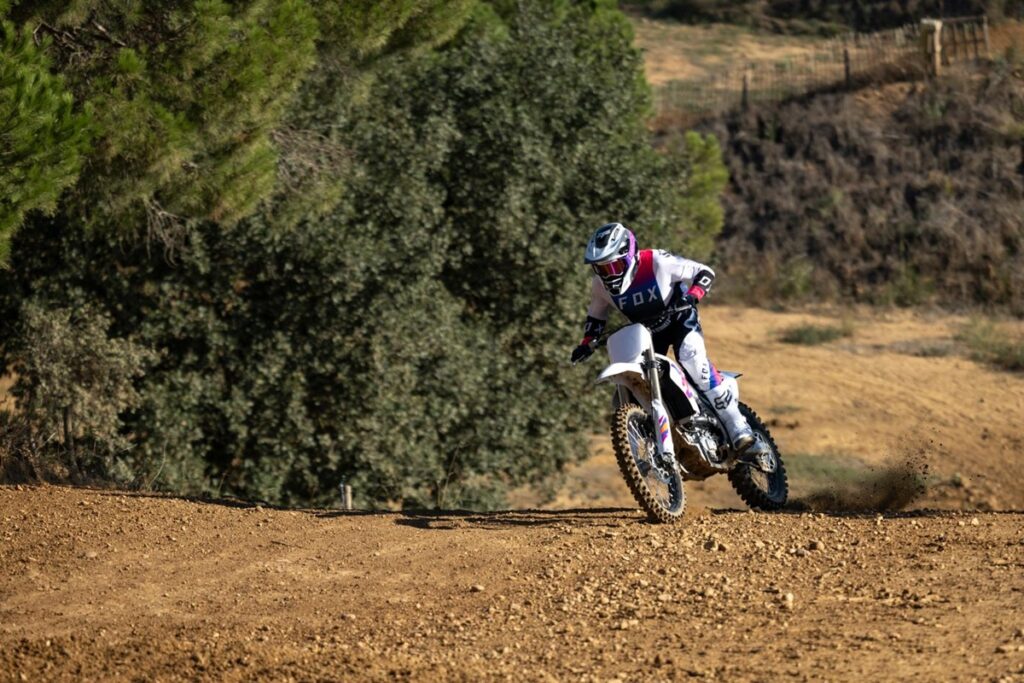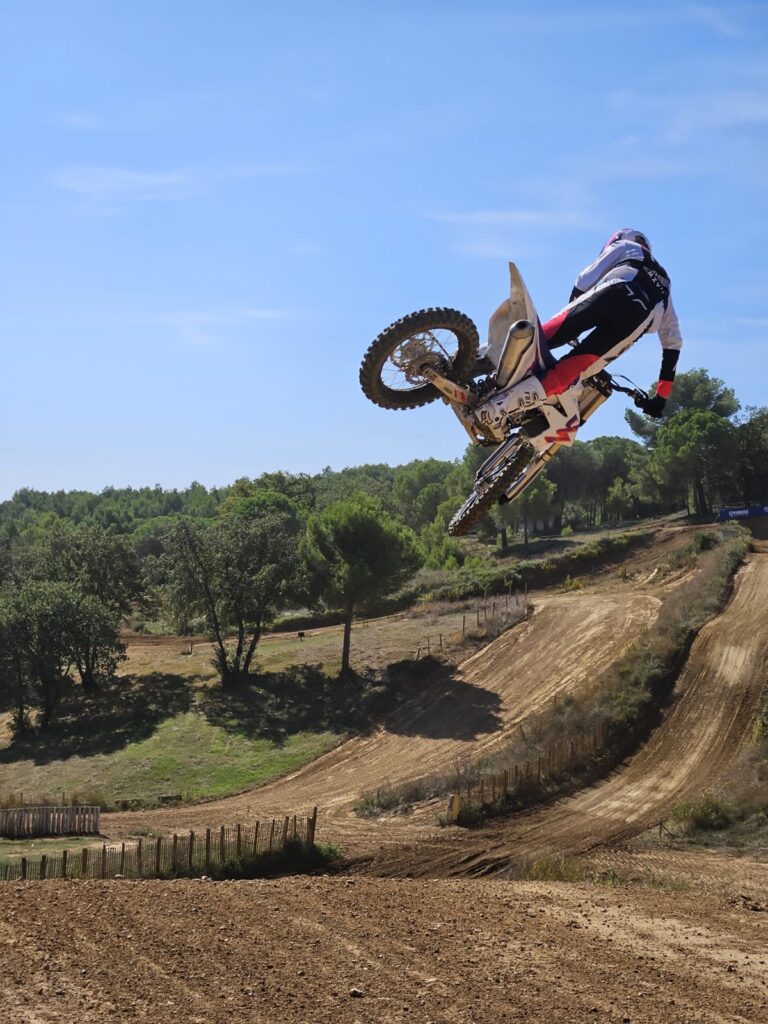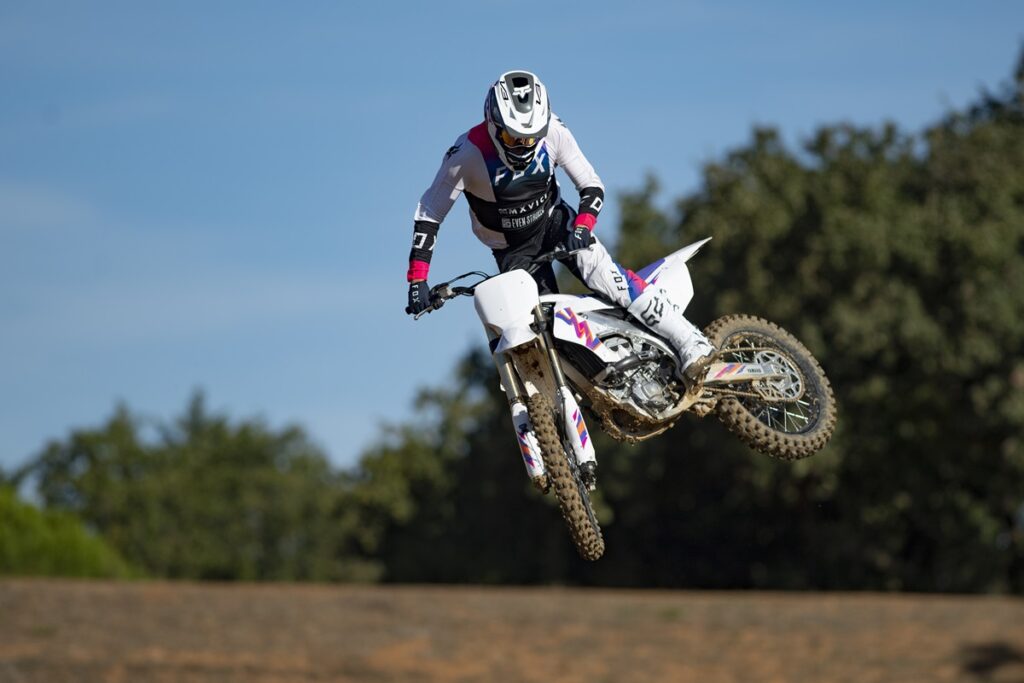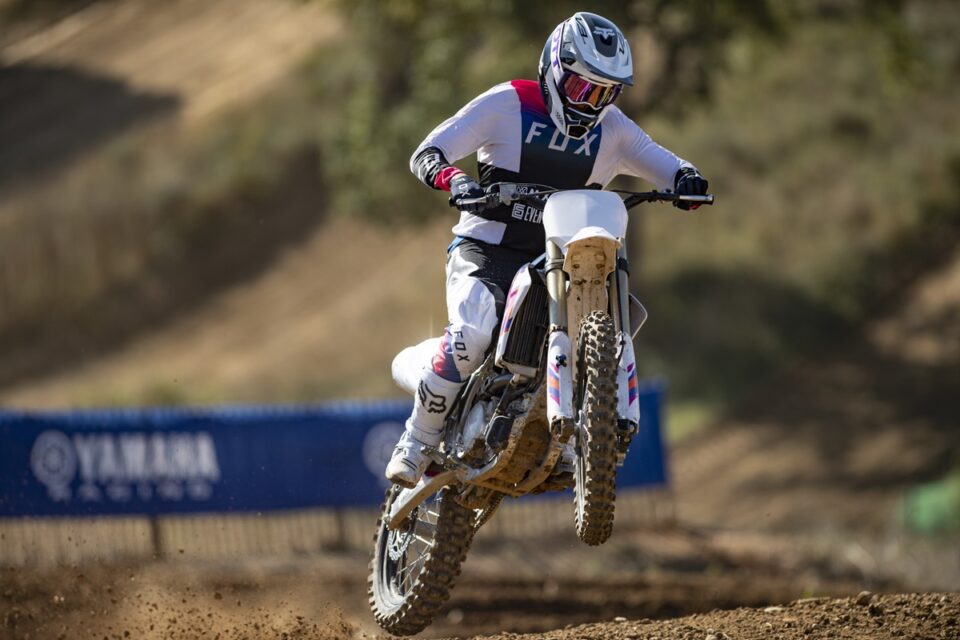I am fresh off of an awesome trip put on by the folks at Yamaha to the south of France to test the new 2024 YZ250F. So wanted to get all the things running around my head down on paper, so to speak.
The success of Yamaha goes back decades, all the way back to the 1950s. The YZ range wasn’t introduced however until 1974, hence the 50th anniversary additions for 2024. Yamaha was the first to jump on board the modern-day 4-stroke hype, posting their first 4-stroke supercross win in 1997 with Doug Henry aboard the YZM400F. The 4-stroke never took off however until 2001 when Yamaha introduced the YZ250F, and the rest, as they say, is history.
Upon first look, the new Yamaha 250F is much narrower than previous years. The rad shrouds are 50mm narrower for the 2024 model. This is due to the air intake being re-routed to come in from under the seat and around the back. Those who have had previous Yamahas will be happy to know that this will increase the life of your filter before having to swap it out for a clean one. The narrower shrouds also make the bike feel much more nimble and manoeuvrable under you.
The concept behind the 2024 model was to make the bike, easier to ride, smoother to ride, and faster. The new frame has a more connected feeling and allows for slimmer rider ergonomics. The new frame is slightly heavier than the old frame but the whole bike is a whopping 1kg lighter than the 2023 model. After sitting through a very thorough and in-depth presentation on the new bike, the main thing that stuck with me was Yamaha was not interested in having the lightest bike. In fact, it was very low on the priority list for them. They would save weight where possible but would not sacrifice handling or power. I rode the bike for over an hour in total and not once did I think that the bike was heavy. I did however think that it was probably the best handling 250F I had ridden and that it pulled like a steam train.

The gap between the foot peg and the seat has been increased by 10mm to give you a more adaptable rider triangle. The tank is also 6mm narrower as well as the subframe lower rails being 0.3mm narrower. All of these little differences make the bike feel agile and easy to throw into thecorners. The new engine mounting bracket and 15mm lower tank rail increase the rigidity of the frame and give it an extremely planted feel over breaking bumps. I went long off of some of the drop downs and landed in some bumps but the bike soaked it up and did a lot of the work for me. It didn’t feel like it wanted to buck me one way or the other where the frame was flexing too much. The more rigid characteristics allow you to really attack the bumps. With updated KYB suspension to match the new frame of the YZ250F, the bike is very level and decreases the amount of pitching and squatting under braking as well as accelerating. The KYB fork also has tool-less compression clickers to make it easier for you to adjust your stiffness with- out having to go back to the van.
The new 250F has also had the same facelift that the 450 received in 2023, with more compact front and rear fenders and a smooth interface between the shrouds and sweet. The front brake line has also been re-routed behind the front plate to protect it from roost as well as decrease the risk of it getting caught in a crash. Yamaha are sticking with their guns and have not abandoned the cable clutch. The bike has a great clutch feel and you can really see why they don’t want to mess about with a hydraulic clutch when their cable clutch is so good.
I did my homework for this test and spoke to quite a few previous Yamaha owners and what some of the main issues were. The two issues that kept cropping up were; the filters becoming very dirty, very quickly. And the cam chains. Well I’ve already addressed the air filter issue, and Yamaha has addressed the cam chain assembly also. The cam chain and sprockets are 30% thicker, improved function, and the new tensioner makes for a much more durable cam chain assembly.
On to the riding then. Like I said, I rode for over an hour but the first thing I noticed straight away was how short 2nd gear was. The bike really likes to be ridden in 3rd and 4th gear. The mid to top power is incredible for a 250F. It won’t however pull 3rd gear out of some of the tighter turns, so you need to round the corner in 2nd and be ready to hook 3rd on the exit as it does rev out quickly in 2nd gear. Once I had this down I was able to weight the back tire and really fly up the hills. The bottom-end power is decent, and as far as starts are concerned it hits the mark. But, if you are not quick with the gear changes it does flatten off in 2nd gear.
The way the bike feels and handles encourage you to be aggressive with the throttle and late on the brakes. I was able to charge deep into the corners and was still able to carry good speed around the corner, unlike some bikes I have ridden where you charge deep into the corner and it wants to stand you up in the rut and rob your momentum.

Even though the bike likes to be ridden hard and aggressive, a less confident or an older rider would still have a great time on this bike. When I mentioned earlier that the bike won’t pull 3rd gear out of some tight turns, what I mean by that is, it won’t pull 3rd up in the optimum rev range. It will comfortably pull 3rd around most tracks and ease its way up into that awesome mid-to-top-range power. Much like a 450 but without that overwhelming power. The new Yamaha 250F comes with a mapping button that allows you to select one of two maps. It is also how you engage the launch control system for the start, but I will get to that later. The Yamaha power tuner app allows you to set 2 fully customised maps if you wish. For map 1 you start the bike and ride as normal. To select map 2, press the big map button once and it will light up blue. This means you are in map 2.
The app has a simple 7-step slide bar system from smooth to aggressive. Once you select your number you can go into the old graph layout and really dissect the options. Yamaha has made sureyou can!t stray too far from the path by adding the slide bar and making it simple to get back to standard. The app also includes a lap timer, suspension setting guides, a real-time dashboard, and a maintenance and race log. Basically, everything you need to go racing.
Now, probably my favourite part of this bike. The launch control system. Those who know me, know I’m a big fan of getting the holeshot. And I have been a big advocate of the launch control, all the way back to 2016 when I first used it on the KTM. Over the years they have become more user-friendly but not as effective in my opinion. However, on the new Yamaha, you can go into the app, and set the rev limiter to anywhere between 8000-14000 RPM. This is a real game-changer. With the introduction of grates at most national events the inconsistency of dirt and rut starts has been lost. You now have almost 100% grip off of the grate. Sounds great right? But this means that when you disengage the clutch the back wheel just bites and you lose a lot of the RPMs and it bogs slightly. Whereas if you were to start on dirt, that bit of wheel spin keeps the revs up in the optimum area. Where I!m going with this is, you can now increase the revs with the launch control on so that when you disengage the clutch on the grate you may drop some revs but you will still be high enough in the revs that it propels you forward. It also works the other way. If you were starting on concrete or wet grass, you want those revs low to decrease the wheel spin. I did several starts on all different conditions and it really is a fantastic system.

As with the 2 engine maps, you can set a launch control map for each one of those maps. Also if you position the mapping box correctly for your hand size it is super easy to flick between the two maps as you ride, should the conditions change.
I am now going to list a few key bits of information that I feel are worth knowing as an owner of this bike:
The new Yamaha comes stock with Dunlop GEOMAX MX33 front and rear, 80/100-21 front, and 110/90-19 rear.
Wet weight of 105kg (1kg less than 2023)
The engine requires 950mm of oil
Fuel tank carries 6.2L
To connect your phone simply, open the wifi page on your phone. Tap the electric starter button,
this will start the WiFi signal. It should then appear in your WiFi options for you to click on. It!s as
simple as that.
Standard gearing of a 50T rear sprocket and 13T front sprocket. This is something that you may
consider altering to extend that 2nd gear. Switching to a 49T rear sprocket may give you an extra
second or two in second gear.
I could go on and on with the technical specification but those are some of the common things I like to know when I’m buying a new bike.
The bike we all got to ride was the 50th Anniversary edition. There are no mechanical differences between the 50th-anniversary edition and the standard blue Yamaha, simply a different livery. The main colours are white and purple, and personally, I think it looks super cool. You do lose the blue rims and blue anodised parts in place of black rims and standard silver parts though.

With most motocross bikes these days they offer upgrade packages, well Yamaha is no different. They offer a variety of GYTR parts (Their name for the Yamaha upgrades). All the way from a full titanium Akrapovic exhaust system, right the way down to carbon fibre parts. The price of an up- grade package fully depends on how far you want to take it, however for the full GYTR kit on a Yamaha 125 which consists of an exhaust system with a titanium muffler, ported cylinder, cylinder head, V-force reed block, jetting kit, exhaust valves, a CDI, upgraded piston and a carbon fibre ig-nition cover. You will not see much change out of £3,500, so expect to be paying north of £4000 for the full 250F GYTR package.
I was however lucky enough to spin a few laps on a fully kitted GYTR YZ125 and let me tell you, that thing has some serious power and torque. Even with my 450 figure on it. Very rarely do I ride a bike that just completely blows me away, but this thing blasted me into next Wednesday. The GYTR kit leaves you wanting for nothing, no flat spots, all the way from bottom-end power right the way to the top-end power. The bike just kept revving and revving, I would love to have seen a data sheet after the session to see what kind of revs I was getting out of it. It is a seriously impressive bit of machinery. Also, race proven by Janis Reisulis who won the 2023 EMX125 aboard a GYTR YZ125. Basically, if the YZ250F GYTR kit is as good as the 125 kit, well that’s going to be a seri- ously powerful motor and plenty good enough to compete at the highest level worldwide. I!ll finish up by saying the 2024 YZ250F is an improvement on an already great bike. Powerful, planted, and agile would be the best three words I could use to describe it. If you’ve ever thought about switching to a YZ250F, or you don’t know if you need a 250F or a 450, I urge you to seriously look at this bike.
The bike retails at:
-£8,900 for the standard blue Yamaha
-£9,100 for the 50th anniversary edition
Personally I really like the 50th anniversary edition, it’s a bit out there and not something that comes around often. So I would spend the extra £200 and get that, but it!s totally down to personal preference.
Finally, I want to say a big thank you to Jeff Turner at Yamaha UK, and all of the ladies and gen- tlemen at Yamaha Europe for inviting us out to test the bike. It was a well-put-together and informa- tive trip, and congratulations on the 50-year mark.
Tested and written by Brad Wheeler (MX Vice)



